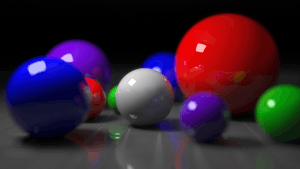V-Ray
|
Render created using V-Ray for Rhinoceros 3D, demonstrating the advanced effects V-Ray is capable of, such as refraction and caustics. | |
| Developer(s) | Chaos Group |
|---|---|
| Stable release | 3.0 / February 4, 2014 |
| Operating system | Linux, Mac OS X and Microsoft Windows |
| Type | Rendering system |
| License | Proprietary commercial software |
| Website |
www |
 | |
| Folded paper: SketchUp drawing rendered using V-Ray, demonstrating shading and global illumination |
 | |
| Render created using V-Ray for Rhinoceros 3D, demonstrating the advanced effects V-Ray is capable of, such as reflection, depth of field, and the shape of the aperture (in this case, a hexagon) |
V-Ray is a commercial rendering plug-in for 3D computer graphics software applications. It is developed by Chaos Group (Bulgarian: Група Хаос), a Bulgarian company based in Sofia, Bulgaria, established in 1997. V-Ray is used in media, entertainment, and design industries such as film and video game production, industrial design, product design and architecture.[1] The company chief architects are Peter Mitev and Vladimir Koilazov.
Overview
V-Ray is a rendering engine that uses advanced techniques, for example global illumination algorithms such as path tracing, photon mapping, irradiance maps and directly computed global illumination. The use of these techniques often makes it preferable to conventional renderers which are provided standard with 3d software, and generally renders using these technique can appear more photo-realistic, as actual lighting effects are more realistically emulated.
The desktop 3D applications that are supported by V-Ray are:
Academic and stand-alone versions of V-Ray are also available.
References
- ↑ chaosgroup.com. About Chaos Group. September 22, 2014.
Further reading
- Francesco Legrenzi, V-Ray - The Complete Guide, 2008
- Markus Kuhlo and Enrico Eggert, Architectural Rendering with 3ds Max and V-Ray: Photorealistic Visualization, Focal Press, 2010
- Ciro Sannino, Photography and Rendering with V-Ray, GC Edizioni, 2012
- Luca Deriu, V-Ray e Progettazione 3D, EPC Editore, 2013
External links
- V-Ray - Free Video Tutorials
- V-Ray Essentials Crash Course - Free Tutorial
- V-Ray - Free Video Tutorials
- V-Ray Help
- Chaos Group Home Page
- V-Ray at rhino3d.com
- A Closer Look At VRAY Architectural Review of V-Ray
- VRay Material Downloads and Resource Library
- ASGVIS Makers of V-Ray for Rhino and V-Ray for SketchUp
- VRAYforC4D - the website of V-Ray for Cinema4d, made by LAUBlab KG
- V-Ray/Blender development.
| ||||||||||||||||||
